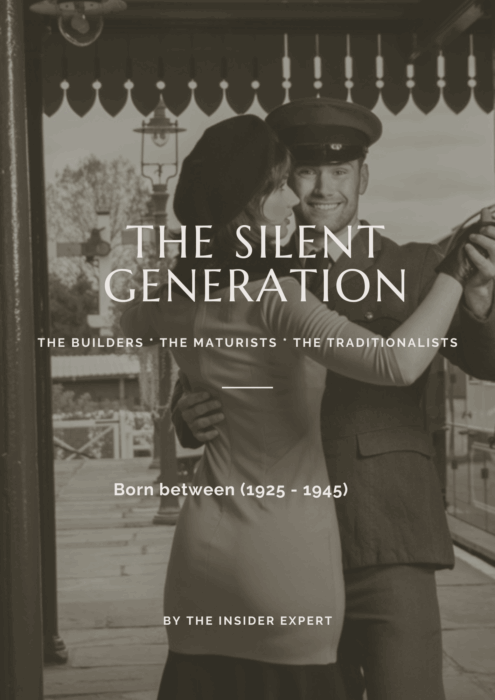SAMPLING FROM:How to Identify Your Writing’s Target Audience

This is a sampling of the content in How to Identify Your Writing’s Target Audience (M1-S207)
TOPIC: How to Target the SILENT DEMOGRAPHIC
This course will be really useful if you’re writing a book aimed at the Silent Generation or about them, as we dive into their key traits, historical events, formative experiences, and mindset. We take a look at the unique products this generation loves and how they like to communicate.
The Silent Generation were shaped by hardship, war, and austerity, producing a mindset of duty, conformity, and quiet resilience. They were less likely to rebel openly than the Baby Boomers who followed, but they laid the stable foundations upon which post-war prosperity and social change could flourish.
Key Traits of the Silent Generation
- Conformity and Discipline – They were often expected to follow rules, respect authority, and avoid drawing undue attention to themselves.
- Hard-working and Industrious – They value loyalty, reliability, and diligence, often placing career and duty above personal fulfilment.
- Frugality – Having grown up in times of scarcity, many developed careful financial habits, saving rather than spending.
- Respect for Institutions – They tended to trust established systems such as government, church, schools, and employers.
- Resilience – Adaptable in the face of hardship, often quietly enduring difficulties rather than openly rebelling.
- Family and Community Oriented – Strong emphasis on family stability, community service, and collective responsibility.
- Cautious and Risk-Averse – Often less inclined to take personal or financial risks compared with later generations.
Historical Events Shaping the Silent Generation
- The Great Depression (1929–1939) – For the older members, childhood was marked by economic hardship and resource scarcity.
- Second World War (1939–1945) – Many were children or teenagers during the war, experiencing rationing, evacuation, bombing, and family disruption.
- Post-War Austerity (1940s–1950s in the UK) – Continued rationing, rebuilding of infrastructure, and a national ethos of “making do and mending.”
- The Cold War (late 1940s–1980s) – Growing up under the shadow of nuclear threat influenced a mindset of caution and restraint.
- Formation of the Welfare State (1940s in the UK) – Introduction of the NHS and broader social safety nets shaped views of government responsibility.
- Civil Rights Movements (1950s–1960s, mainly in the US) – Though younger members witnessed these events, many were raised with more traditional attitudes towards authority and social order.
Formative Experiences
- Childhood Scarcity – Rationing, shared housing, hand-me-downs, and limited luxuries.
- Community Responsibility – Neighbours supporting one another through hardships, reinforced by wartime spirit.
- Early Work Ethic – Many left school early to work, supporting families or national recovery.
- Respect for Hierarchy – From school discipline to workplace authority, hierarchy was rarely questioned openly.
- Traditional Family Structures – Strong emphasis on marriage, duty to spouse, and raising children within clearly defined roles.
- Limited Consumer Culture – Unlike later generations, they grew up without the influence of advertising-driven abundance.
Mindset of the Silent Generation
- “Keep Your Head Down” Mentality – They were often taught not to make a fuss or seek the limelight.
- Duty Before Self – A focus on obligations—to family, employer, or nation—before personal ambitions.
- Patience and Restraint – Enduring hardships without complaint, believing rewards come through perseverance.
- Security-Seeking – Valued steady jobs, home ownership, and financial safety over risk-taking.
- Social Conservatism – Often upheld traditional values, although some became quiet reformers in their later years.
- Silent Influence – Though not known for protest, their disciplined and consistent efforts underpinned much of the economic and social rebuilding of the mid-20th century.
Questions to Ask Yourself that May Help

-
What years define the Silent Generation in my context?
-
What major events shaped their childhood and young adulthood?
-
How did the Second World War affect their formative years?
-
How did post-war austerity shape their habits and outlook?
-
What role did community and neighbourhood ties play in their lives?
-
How important is religion or church life for many in this generation?
-
How do they typically view family responsibilities and roles?
-
What do they value most—security, stability, or tradition?
-
How did the creation of the NHS influence their sense of social responsibility?
-
What generational sayings or idioms resonate with them (e.g., “make do and mend”)?
-
What kinds of books do they prefer—history, biography, crime, romance, or faith-based titles?
-
Do they value practical guides over entertainment, or vice versa?
-
How important are large-print editions or audio versions?
-
Do they enjoy nostalgic themes that reflect their youth?
-
Are they more likely to prefer factual accounts or imaginative fiction?
-
How do they feel about contemporary slang or modern narrative styles?
-
Do they enjoy stories about resilience, family, and moral dilemmas?
-
How do they respond to strong language or graphic violence in writing?
-
Do they prefer stand-alone books or series they can follow?
-
Are shorter chapters or slower pacing more appealing to them?
- How comfortable are they with e-books and tablets?
- Do they prefer physical books they can hold?
- How many in this generation are active online readers?
- How do they usually hear about new books—newspapers, radio, recommendations?
- Are they likely to follow book clubs or library groups?
- How do they feel about marketing via social media compared with traditional methods?
- Would they respond better to posters in local shops or digital adverts?
- Do they trust online reviews, or prefer word-of-mouth recommendations?
- What role do libraries still play in their reading habits?
- Would they welcome personalised letters or newsletters from authors?
-
What does “duty” mean to them, and how is it reflected in reading material?
-
How important is patriotism in shaping their interests?
-
How do they relate to themes of sacrifice, resilience, and loyalty?
-
What nostalgic memories (rationing, evacuees, rebuilding) still resonate with them?
-
How important is financial frugality in their choices as readers?
-
Do they appreciate stories grounded in tradition and continuity?
-
How do they view authority and institutions in literature?
-
What kinds of humour appeal to them—gentle, witty, or satirical?
-
Are they drawn to intergenerational themes (grandparents, legacy, family ties)?
-
Do they prefer stories that affirm long-held values, or ones that challenge them carefully?
- Where can I best reach this demographic—community halls, local clubs, veterans’ organisations?
- How much does price matter for them compared with quality?
- What role does nostalgia marketing (wartime imagery, vintage design) play in appealing to them?
- Do they prefer formal communication styles over casual ones?
- Are endorsements from trusted public figures or institutions more persuasive than celebrity promotion?
- Would they prefer face-to-face engagement, such as talks and readings, over online events?
- How important is trustworthiness and reliability in an author’s reputation?
- Do they appreciate supplementary materials—family history charts, photographs, maps?
- Are they more inclined to support local authors and publishers?
- How can I demonstrate respect for their lived experiences while still engaging them with new ideas?
PDF Workbook Instructions

Download your PDF workbook and save it to your a folder you have created on your computer specifically for saving your ideas, so you can refer to it again and again.
This interactive PDF workbook provides a convenient platform for directly typing and organising your ideas.
Open the interactive PDF workbook in a PDF viewer and type your answers in.
You can print your PDF workbook out (be sure to select· scale size to fit your printer setting) and place them into your ideas binder.
Open the interactive PDF workbook in a PDF viewer and type your answers in.
Want More
Are you interested in learning more after giving the sampling a shot? Hey, are you interested in picking up some new skills to help you identify your book’s audience and target markets better?

How to Identify Your Writing’s Target Audience (M1-S207)
If you’re after a more focused learning experience, this option could be just what you need. This course is designed to help you understand your target market and figure out who your audience is. That way, you can customise your marketing and messages to effectively reach your readers.
You’ll get 14 lessons to learn at your own pace, and you can go back and review the material as often as you need to really grasp the concepts.
